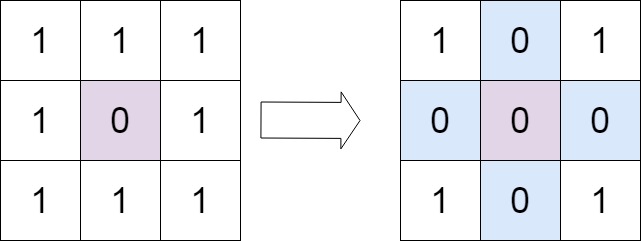動機
讓題我想起多allocate一塊記憶體去當dummy的手法 但是這裡不用多allocate,而是利用matrix的第一列與第一排
而如果第一列與第一排原本就該被處理的話,就用變數存狀態!!
這裡的教訓是狀態與被處理的資料勢必要分開,就像loop會看cond會不會收斂,有關的index會不會收斂,遞迴的變數會不會往base case靠近,是設計時的規則!!
Problem
Given an m x n integer matrix matrix, if an element is 0, set its entire row and column to 0's, and return the matrix.
You must do it in place.
Example 1:

Input: matrix = [[1,1,1],[1,0,1],[1,1,1]]Output: [[1,0,1],[0,0,0],[1,0,1]]
Example 2:

Input: matrix = [[0,1,2,0],[3,4,5,2],[1,3,1,5]]Output: [[0,0,0,0],[0,4,5,0],[0,3,1,0]]
Constraints:
m == matrix.lengthn == matrix[0].length1 <= m, n <= 200-231 <= matrix[i][j] <= 231 - 1
Follow up:
- A straightforward solution using
O(mn)space is probably a bad idea. - A simple improvement uses
O(m + n)space, but still not the best solution. - Could you devise a constant space solution?
Sol
如果不追求記憶體用量的話,其實記下所有有0的點就好
如果不想用其他記憶體,就要有地方放mark,區分這是原本的0還是後面加的,所以在python之類的語言可以用None之類的去區分
但像c之類的就沒辦法,這時需要別的方法 可以把第一列與第一排當成checklist,這樣就沒問題了
但要記得處理原本第一列與第一排就有0的case
class Solution:
def setZeroes(self, ms: List[List[int]]) -> None:
Col1,Row1 = False, False
for i in range(len(ms)):
if ms[i][0] == 0:
Col1 = True
for j in range(len(ms[0])):
if ms[0][j] == 0:
Row1 = True
for i in range(1,len(ms)):
for j in range(1,len(ms[0])):
if ms[i][j] == 0:
ms[i][0] = ms[0][j] = 0
for i in range(1,len(ms)):
if ms[i][0] == 0:
for j in range(1,len(ms[0])):
ms[i][j] = 0
for j in range(1,len(ms[0])):
if ms[0][j] == 0:
for i in range(1,len(ms)):
ms[i][j] = 0
if Col1:
for i in range(len(ms)):
ms[i][0] = 0
if Row1:
for j in range(len(ms[0])):
ms[0][j] = 0